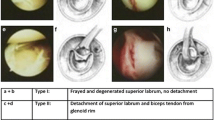Abstract
Purpose
Quantitative and qualitative kinematic analyses of subacromial impingement by 1.2T open MRI were performed to determine the location of impingement and the involvement of the acromioclavicular joint.
Methods
In 20 healthy shoulders, 10 sequential images in the scapular plane were taken in a 10-s pause at equal intervals from 30° to maximum abduction in neutral and internal rotation. The distances between the rotator cuff (RC) and the acromion and the acromioclavicular joint were measured. To comprehend the positional relationships, cadaveric specimens were also observed.
Results
Although asymptomatic, the RC came into contact with the acromion and the acromioclavicular joint in six and five cases, respectively. The superior RC acted as a depressor for the humeral head against the acromion as the shoulder elevated. The mean elevation angle and distance at the closest position between the RC and the acromion in neutral rotation were 93.5° and 1.6 mm, respectively, while those between the RC and the acromioclavicular joint were 86.7° and 2.0 mm. When comparing this distance and angle, there was no significant difference between the RC to the acromion and to the acromioclavicular joint. The minimum distance between the RC and the acromion was significantly shorter than that between the greater tuberosity and the acromion. The location of RC closest to the acromion and the acromioclavicular joint differed significantly.
Conclusion
Although asymptomatic, contact was found between the RC and the acromion and the acromioclavicular joint. The important role of the RC to prevent impingement was observed, and hence, dysfunction of the RC could lead to impingement that could result in a RC lesion. The RC lesions may differ when they are caused by impingement from either the acromion or the acromioclavicular joint.




Similar content being viewed by others
References
Chen AL, Rokito AS, Zuckerman JD (2003) The role of the acromioclavicular joint in impingement syndrome. Clin Sports Med 22:343–357
Goldberg BA, Lippitt SB, Matsen FA 3rd (2001) Improvement in comfort and function after cuff repair without acromioplasty. Clin Orthop Relat Res 390:142–150
Han KJ, Cho JH, Han SH, Hyun HS, Lee DH (2012) Subacromial impingement syndrome secondary to scapulothoracic dyskinesia. Knee Surg Sports Traumatol Arthrosc 20:1958–1960
Hashimoto T, Nobuhara K, Hamada T (2003) Pathologic evidence of degeneration as a primary cause of rotator cuff tear. Clin Orthop Relat Res 415:111–120
Kessel L, Watson M (1977) The painful arc syndrome. Clinical classification as a guide to management. J Bone Joint Surg Br 59:166–172
Ketola S, Lehtinen J, Rousi T, Nissinen M, Huhtala H, Konttinen YT, Arnala I (2013) No evidence of long-term benefits of arthroscopic acromioplasty in the treatment of shoulder impingement syndrome: five-year results of a randomised controlled trial. Bone Joint Res 2:132–139
McCallister WV, Parsons IM, Titelman RM, Matsen FA 3rd (2005) Open rotator cuff repair without acromioplasty. J Bone Joint Surg Am 87:1278–1283
Michener LA, Subasi Yesilyaprak SS, Seitz AL, Timmons MK, Walsworth MK (2013) Supraspinatus tendon and subacromial space parameters measured on ultrasonographic imaging in subacromial impingement syndrome. Knee Surg Sports Traumatol Arthrosc. doi:10.1007/s00167-013-2542-8
Mochizuki T, Sugaya H, Uomizu M, Maeda K, Matsuki K, Sekiya I, Muneta T, Akita K (2008) Humeral insertion of the supraspinatus and infraspinatus. New anatomical findings regarding the footprint of the rotator cuff. J Bone Joint Surg Am 90:962–969
Neer CS II (1972) Anterior acromioplasty for the chronic impingement syndrome in the shoulder: a preliminary report. J Bone Joint Surg Am 54:41–50
Nyffeler RW, Werner CM, Sukthankar A, Schmid MR, Gerber C (2006) Association of a large lateral extension of the acromion with rotator cuff tears. J Bone Joint Surg Am 88:800–805
Pappas GP, Blemker SS, Beaulieu CF, McAdams TR, Whalen ST, Gold GE (2006) In vivo anatomy of the Neer and Hawkins sign positions for shoulder impingement. J Shoulder Elbow Surg 15:40–49
Roberts CS, Davila JN, Hushek SG, Tillett ED, Corrigan TM (2002) Magnetic resonance imaging analysis of the subacromial space in the impingement sign positions. J Shoulder Elbow Surg 11:595–596
Schneeberger AG, Nyffeler RW, Gerber C (1998) Structural changes of the rotator cuff caused by experimental subacromial impingement in the rat. J Shoulder Elbow Surg 7:375–380
Thiel W (1992) An arterial substance for subsequent injection during the preservation of the whole corpse. Ann Anat 174:197–200
Wiley AM (1991) Superior humeral dislocation. A complication following decompression and debridement for rotator cuff tears. Clin Orthop Relat Res 263:135–141
Wuelker N, Plitz W, Roetman B (1994) Biomechanical data concerning the shoulder impingement syndrome. Clin Orthop Relat Res 303:242–249
Yamamoto N, Muraki T, Sperling JW, Steinmann SP, Itoi E, Cofield RH, An KN (2009) Impingement mechanisms of the Neer and Hawkins signs. J Shoulder Elbow Surg 18:942–947
Yamamoto N, Muraki T, Sperling JW, Steinmann SP, Itoi E, Cofield RH, An KN (2010) Contact between the coracoacromial arch and the rotator cuff tendons in nonpathologic situations: a cadaveric study. J Shoulder Elbow Surg 19:681–687
Acknowledgments
This study was partly supported by a Grant-in-Aid for Scientific Research from the Ministry of Education, Culture, Sports (C) (No. 20590168) and also by a grant from Nokyo Kyosai Research Institute (Agricultural Cooperative Insurance Research Institute). We thank Eiji Okamoto, R.T. and Youichi Ito, for valuable assistance in this study.
Author information
Authors and Affiliations
Corresponding author
Rights and permissions
About this article
Cite this article
Tasaki, A., Nimura, A., Nozaki, T. et al. Quantitative and qualitative analyses of subacromial impingement by kinematic open MRI. Knee Surg Sports Traumatol Arthrosc 23, 1489–1497 (2015). https://doi.org/10.1007/s00167-014-2876-x
Received:
Accepted:
Published:
Issue Date:
DOI: https://doi.org/10.1007/s00167-014-2876-x




